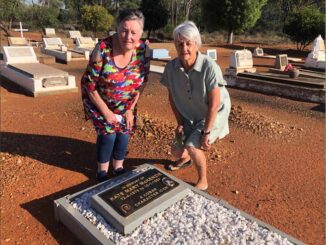
Farmers around the state are calling for more resources to combat a huge rise in the number of feral pigs which are destroying their properties and killing their stock.
The Cobar Weekly spoke with a number of landholders across the region and all report seeing dramatic increases in pig numbers.
“It seems to be a problem for everyone you talk to at the moment,” Cathy Francisco, from Carline Station north of Cobar, said.
“It’s definitely escalated and they’re much bigger and breeding very well.
“We’ll regularly see mum, dad and about eight little ones,” she said.
Cathy said they are currently lambing and, along with baby goats, the pigs are having a “feeding frenzy”.
In addition to dead carcasses, Cathy said there’s also plenty of evidence of where they’ve been digging, and also wallowing in the tanks which is making them muddy which is a nuisance for stock.
Cathy’s husband Glen regularly patrols the property shooting pigs each day and also goes out at night shooting.
Driving in and out of town, Cathy said she’s also seeing more pigs on the Kidman Way.
“It’s not always at night, we see them during the day which is a danger to travellers.
“There’s no baiting programs out our way.
“It definitely is becoming a real problem and something needs to be done about it.”
Belinda Blake, also north of Cobar, reports numbers have swelled on their property due to the wet conditions last year and the abundance of feed on the property.
“We estimate upwards of a 50 per cent reduction in lambs due to the impact of pigs, along with damage to pastures and wetlands,” Belinda said.
Megan Mosely in the south east of the shire said their pig numbers were “out of control”.
“We’ve been on Etiwanda 26 years and this is by far the worst we’ve seen them.
“Fox numbers are also very high,” Megan reported.
Bob Sinclair in the south west of the shire said he’s got a shooter in to help control the numbers.
“Every night he’s shooting two or three, when it used to be we’d get two or three a week,” Bob said.
He said with a recent Barbers Pole worm infestation in the area that killed stock, it was easy picking for the pigs with a lot of dead animals on the ground to feed off.
Bob said they have been rooting up the ground, in particular in the water drains, and wrecking fences.
Sarah Johnson at Gilgunnia Station, 40km north of Cobar said 12 months ago it was very hard to catch a pig.
“Now we’re seeing mobs of 20-40 pigs in the crops. It’s not a big crop, but they’ve laid about 20 per cent of it down,” Sarah said.
“We’ve had them swimming in our stock feed troughs making them muddy and also breaking them. They’ve been damaging our spear traps for goats also.”
Landholders have reported them coming in closer to their homes, with one reporting them rooting under their clothesline.
Sarah said they recently caught a big boar near their house.
“I think the best help we could receive is help with some pig traps. Poison is too dangerous for working dogs,” she said.
NSW Farmers President Xavier Martin said there are millions of feral pigs breeding and rampaging across the countryside, thriving after years of high rainfall, attacking native animals and livestock, and causing massive damage to crops and infrastructure.
“The past three years have been a boom time for pigs,” Mr Martin said.
“While government control efforts had made a slight dent in the overall number of pigs in certain areas, there were too many reports of a booming breeding population to ignore.
“From what we’re hearing members tell us they’ve never seen pigs this bad before,” he said.
“Aerial shooting over the past year saw 80 per cent more pigs culled than the year before, and authorities have distributed 74 tonnes of baits to landholders, but the numbers continue to grow, particularly on public land.
“It’s clear the pig numbers are growing out of control now, and we need a drastic and sustained increase in resources for everyone involved to get on top of the problem once and for all.”
According to Local Land Services, more than 63,000 feral pigs had been culled as part of coordinated aerial and on-ground shooting and baiting in the past 12 months. Mr Martin said anecdotal reports from farmers meant the actual numbers were likely far higher.
He said there were serious concerns about what would happen after June 30, when the State Government’s additional pig control funding ended.
“Trying to keep the pig numbers down farm-by-farm is a bit like trying to put out half a fire – if you’re not tackling the whole problem methodically, it’ll just keep coming back,” Mr Martin said.
“A lack of effective control on public lands is undermining our collective efforts, and we know that’s where the pigs are breeding because we see them coming onto our farms from public lands.
“We need more resources and a solid commitment from all parties involved to tackle feral pigs so we can get on top of them and stay on top of them.”


